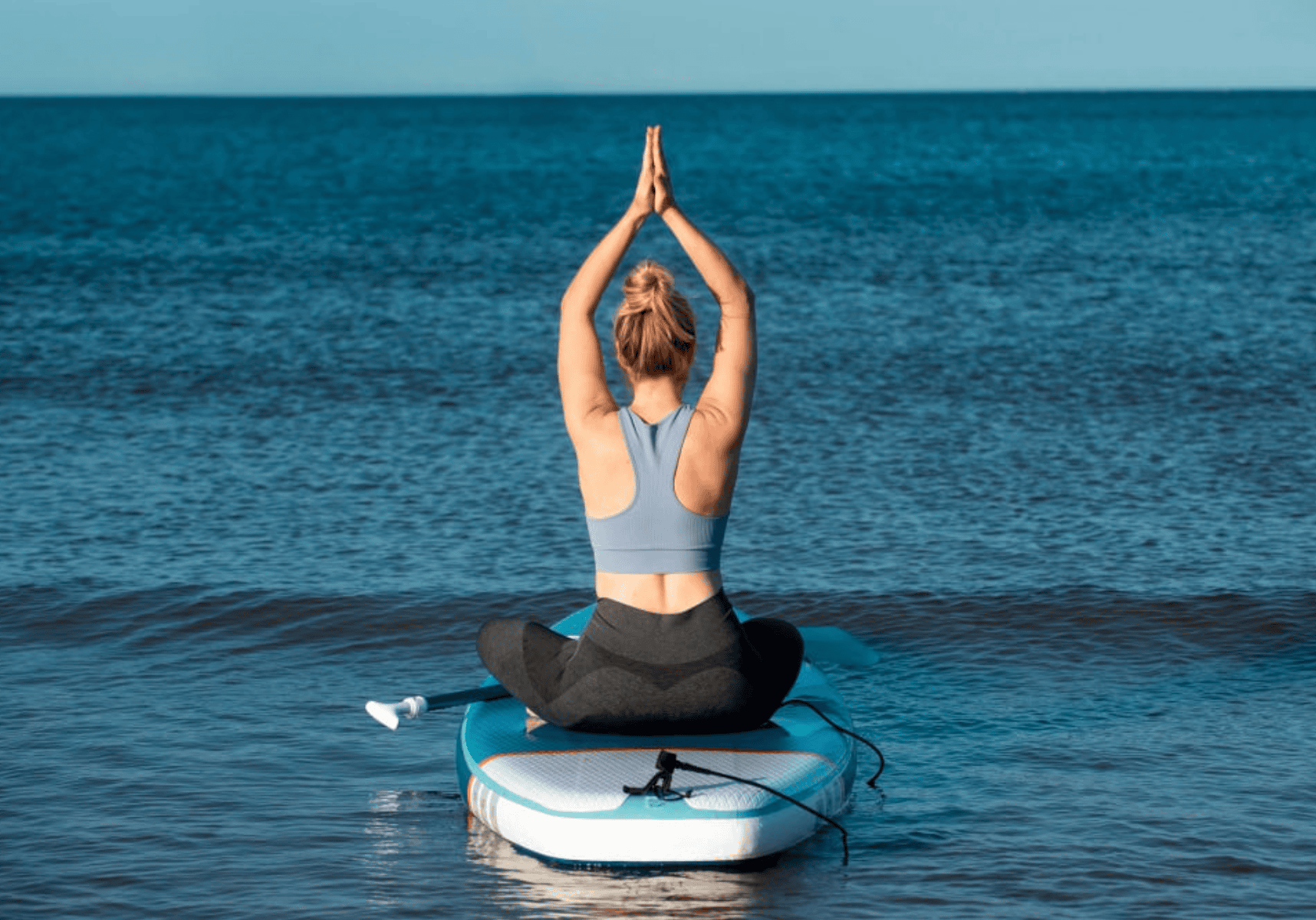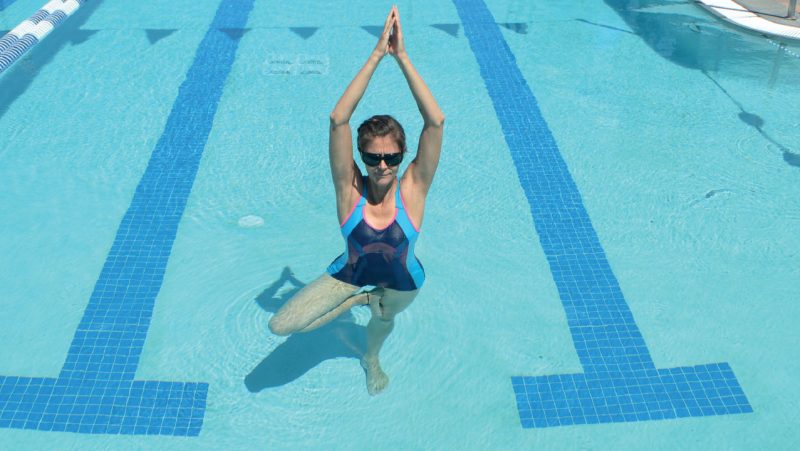
Beginners Guide to Aqua Yoga
Discovering Serenity and Strength Through Aqua Yoga - By Allison Eaton
Reading time: 5 minutes
Aqua yoga offers a unique blend of serenity and strength, combining the meditative aspects of yoga with the buoyancy and resistance of water. As you dip your toes into this revitalising practice, prepare to embark on a journey of wellness and self-discovery.
What is Aqua Yoga?
Aqua yoga, also known as water yoga or pool yoga, is a gentle yet effective form of exercise that takes place in a pool or aquatic environment. It merges the principles of traditional yoga with the therapeutic properties of water, offering practitioners a dynamic and rejuvenating experience.
Benefits of Aqua Yoga
-
- Enhancing Flexibility and Range of Motion
Aqua yoga encourages fluid movements and gentle stretches, allowing for increased flexibility and improved joint mobility. The supportive nature of water reduces strain on the muscles and facilitates deeper stretches without excessive strain.
-
- Building Strength with Resistance
The resistance provided by water serves as a natural form of strength training, engaging muscles throughout the body. As you move against the water's resistance, you'll build muscle tone and improve overall strength without the need for cumbersome equipment.
-
- Joint Stress and Pressure
Water's buoyancy alleviates pressure on the joints, making aqua yoga an ideal practice for individuals with arthritis, joint pain, or mobility issues. The buoyant properties of water support the body, reducing the impact on vulnerable joints while still providing a challenging workout.
-
- Heightening Mind-Body Awareness
Practicing yoga in the water encourages heightened awareness of the body and breath. The gentle resistance of the water encourages mindfulness, allowing practitioners to cultivate a deeper connection between mind, body, and spirit.
Preparing for Your Aqua Yoga Practice
Choosing the Right Location
Before diving into your aqua yoga practice, consider your options for practice locations. Whether you prefer the serene ambiance of a pool, the natural beauty of a lake, or the rhythmic waves of the ocean, choose a setting that resonates with you and suits your comfort level.
-
- Costa Rica
-
- Hawaii
-
- RishiKesh
-
- Austin
-
- Denver
-
- Los Angeles
Essential Equipment and Attire
When preparing for aqua yoga, selecting the right equipment and attire is essential for a safe and enjoyable practice. Opt for swimwear that allows for freedom of movement and consider investing in specialised aqua yoga props such as flotation devices, mats, and water bottles to enhance your experience.
Safety Considerations
As with any physical activity, safety should be a top priority in aqua yoga. Before beginning your practice, assess the water depth and conditions to ensure a safe environment. Additionally, monitor water temperature and stay hydrated throughout your session to prevent overheating or dehydration.
Basic Aqua Yoga Techniques
Mindful Breathing in the Water
Practicing pranayama techniques in the water offers a unique opportunity to deepen your breath and enhance relaxation. Experiment with breath awareness exercises, such as inhaling deeply as you float on your back or exhaling slowly as you submerge beneath the surface.
Foundation Poses for Stability and Balance
Begin your aqua yoga practice with foundational poses modified for the water environment. Explore variations of mountain pose (Tadasana) and the warrior series (Virabhadrasana) to cultivate stability, balance, and grounding amidst the fluidity of the water.
Flowing Movements with Fluidity
Embrace the fluid nature of water with flowing movements and sequences designed to promote grace and ease in your practice. From sun salutations (Surya Namaskar) with a watery twist to seamless transitions between poses, allow your body to move with fluidity and grace.
Traditional Poses for the Water
Downward-Facing Dog (Adho Mukha Svanasana) Variation
Utilise the support of the pool wall to enhance alignment and stability in downward-facing dog. By pressing your palms into the wall and extending through your spine, you'll experience a deeper stretch while maintaining proper form.
Tree Pose (Vrksasana) Modified for Balance
Explore the gentle sway of the water as you adapt tree pose for the aquatic environment. Root down through one foot while allowing the opposite knee to float gently outward, finding balance and stability amidst the subtle movements of the water.
Corpse Pose (Savasana) Surrender in the Water
Float effortlessly on your back in a state of deep relaxation and surrender during aquatic savasana. Allow the buoyancy of the water to support your body as you release tension, quiet the mind, and immerse yourself in a state of blissful serenity.
Creating Your Aqua Yoga Routine
Setting Intentions and Goals
Before beginning your aqua yoga practice, take a moment to set clear intentions and goals for your session. Whether you're seeking relaxation, strength-building, or increased flexibility, establishing purposeful objectives will guide your practice and keep you focused.
Structuring Your Session
Warm-up: Gentle Movements to Prepare the Body
Start your aqua yoga practice with a gentle warm-up sequence to prepare the body for movement and relaxation. Incorporate dynamic stretches, joint rotations, and breath awareness exercises to awaken the muscles and cultivate presence.
Main Sequence: Exploring Poses and Transitions
Delve into the heart of your aqua yoga practice with a dynamic sequence of poses and transitions tailored to your skill level and intentions. Flow gracefully from one pose to the next, allowing the rhythm of your breath to guide your movements and deepen your practice.
Cool Down: Restorative Poses and Final Relaxation
Conclude your aqua yoga practice with a series of restorative poses designed to promote relaxation and renewal. Sink into gentle stretches, supported reclining poses, and soothing breathwork as you unwind and release tension from the body and mind.
Incorporating Variations and Modifications
Tailoring Poses to Your Comfort and Skill Level
Modify and adapt poses as needed to accommodate your unique body and abilities. Listen to your body's cues and adjust accordingly, finding variations that offer both challenge and support while honoring your physical limitations and preferences.
Embracing Adaptations for Physical Limitations or Injuries
If you're managing physical limitations or recovering from injury, embrace adaptations and modifications to ensure a safe and effective practice. Work closely with a qualified aqua yoga instructor to explore personalised modifications that support your healing journey and promote overall well-being.
Tips for a Successful Aqua Yoga Experience
Embracing Playfulness and Exploration
Approach your aqua yoga practice with a spirit of playfulness and curiosity, allowing yourself to explore new movements and sensations with childlike wonder. Release the need for perfection and embrace the joy of movement as you navigate the fluidity of the water.
Practicing Mindfulness in the Water
Cultivate mindfulness and presence in your aqua yoga practice by tuning into the sensations of the water, the rhythm of your breath, and the subtle nuances of each movement. Heighten your awareness of the present moment, allowing yourself to fully immerse in the transformative power of water and yoga.
Listening to Your Body
Honor your body's wisdom and intuition as you navigate your aqua yoga practice, tuning into its signals and responding with kindness and compassion. Pay attention to areas of tension or discomfort, making adjustments as needed to ensure a safe and enjoyable experience.
Staying Hydrated and Nourished
Prioritise hydration and nourishment before, during, and after your aqua yoga practice to support optimal performance and recovery.
Prioritising Fluid Intake and Post-Practice Nutrition
Maintaining proper hydration is essential for sustaining energy levels and supporting overall well-being during your aqua yoga practice. Be sure to hydrate adequately before entering the water, and keep a water bottle nearby to sip on throughout your session. Replenish lost fluids post-practice with hydrating beverages such as water, coconut water, or electrolyte-enhanced drinks to help restore balance and replenish electrolytes.
In addition to staying hydrated, nourishing your body with nutrient-rich foods is key to supporting recovery and promoting vitality. Enjoy a balanced meal or snack containing a combination of carbohydrates, protein, and healthy fats within an hour or two of completing your aqua yoga practice. Incorporate hydrating foods such as fruits and vegetables, lean proteins, and whole grains to replenish energy stores and support muscle repair and growth.
Conclusion
Dive into the transformative world of aqua yoga and discover a new dimension of joy, fluidity, and wellness in the water. As you embark on your journey, remember to approach your practice with an open heart and a sense of curiosity, embracing the unique challenges and rewards that aqua yoga has to offer.
Whether you're seeking to enhance flexibility, build strength, or cultivate mindfulness, aqua yoga provides a refreshing and accessible pathway to holistic well-being. So, grab your swimsuit, take a deep breath, and immerse yourself in the healing embrace of aqua yoga.







